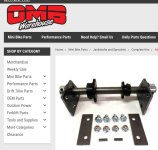justaperson76
10 mW
- Joined
- Apr 17, 2022
- Messages
- 31
Hello, I have an old 50cc chinese ATV, fairly small thing. I am converting it to electric using this Vevor controller/motor combo:
https://www.vevor.com.au/brushless-...w-kit-go-kart-bicycle-powerful-p_010194063736
Basically it's a 2kw brushless motor with a 48v 35A controller.
I hooked it all up and although the wheels spin fast, there doesn't seem to be much torque. It can't get me up a small hill. I am using 8awg wire for the power, connecting 4 12v SLA batteries in series - same ones you get from the powerwheels cars, like this:
https://www.ebay.com.au/itm/1541970...kw9uTECSWL9EH_Dubd_TLpYi31bxAE5BoCXV0QAvD_BwE
I tested the amps. I just sit the ATV before a hill to force it to use maximum current (stall current). When I put a clamp metre around one of the cables going to the batteries, it goes to about 23A for a second or so then drops down to about 15A. After a few seconds, all three phase wires going to the motor get fairly warm to touch. I know they're connected the right way as the motor and controller have colour coded wires, which are connected through a 60A connection block.
So my question is, do you think this could be the batteries not good enough to provide 35A, or the controller? I can provide pictures if it helps, but it looks like it's all connected fine using proper thick cabling.
Thanks for any help!
https://www.vevor.com.au/brushless-...w-kit-go-kart-bicycle-powerful-p_010194063736
Basically it's a 2kw brushless motor with a 48v 35A controller.
I hooked it all up and although the wheels spin fast, there doesn't seem to be much torque. It can't get me up a small hill. I am using 8awg wire for the power, connecting 4 12v SLA batteries in series - same ones you get from the powerwheels cars, like this:
https://www.ebay.com.au/itm/1541970...kw9uTECSWL9EH_Dubd_TLpYi31bxAE5BoCXV0QAvD_BwE
I tested the amps. I just sit the ATV before a hill to force it to use maximum current (stall current). When I put a clamp metre around one of the cables going to the batteries, it goes to about 23A for a second or so then drops down to about 15A. After a few seconds, all three phase wires going to the motor get fairly warm to touch. I know they're connected the right way as the motor and controller have colour coded wires, which are connected through a 60A connection block.
So my question is, do you think this could be the batteries not good enough to provide 35A, or the controller? I can provide pictures if it helps, but it looks like it's all connected fine using proper thick cabling.
Thanks for any help!


![Samsung%20INR18650-25R%202500mAh%20(Green)-Capacity[1].png Samsung%20INR18650-25R%202500mAh%20(Green)-Capacity[1].png](https://endless-sphere.com/sphere/data/attachments/179/179630-1ea10d36115a18fb05767b622b90d984.jpg)
